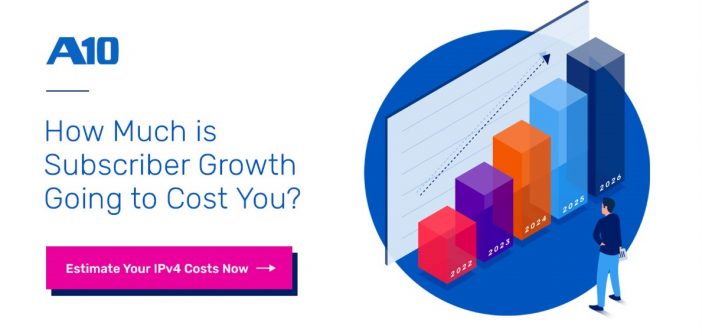A10 recently published a quick assessment tool that allows network analysts and their management to structure some of the uncertainties involved in the analysis of IPv4 costs. It is an interactive, online tool that provides three potential IPv4 cost scenarios and estimates subscribers that can be supported based on two different traffic profiles. All inputs and assumptions behind the model use actual industry data.
IPv4 Exhaustion Creates Rollercoaster Costs
The “free” IPv4 addresses from the Regional Internet Registries (RIRs) have now been fully allocated. RIPE (the Regional Internet Registry for Europe, the Middle East, and parts of Central Asia) made its last 22-block assignment in November 2019. As a result, IPv4 addresses are in short supply and prices from open market sources have skyrocketed.
In 2021, the open market “price” of an IPv4 address in a 256 address block ( /24) in North America, jumped from a low of $25 each in January to a high of $60 in late November. The price in the first four months of 2022 has hovered between $50 – $55. What would be the expected price for an ISP looking to acquire more IPv4 addresses to sustain growth in the next few years? Will that high growth in price continue for the next five years, or has it now “topped out” and will increase only marginally?
The A10 IPv4 Address Cost Estimator tool provides three reasonable cost scenarios that can be considered for predicting future IPv4 acquisition costs. It then calculates the total cost of acquiring these IPv4 addresses over five years, given the subscriber growth and price scenario chosen.
In these three scenarios, it is assumed that the service provider can expect to pay the average cost, not the highest peak price.
- Conservative: Costs have topped out. The skyrocketing costs of IPv4 addresses have stopped and only small increases (~5%) can be expected over the next five years. By 2026, the average price will hit $47.
- Moderate: The average cost will increase at the average rate of the last three years (18%) and reach $83 in 2026.
- Aggressive: The average cost will increase 25% annually and will reach $112 in 2026.
There is an additional worst-case scenario that the A10 IPv4 Address Cost Estimator tool does not provide. That is the service provider attempting to quickly acquire additional IPv4 addresses is forced to pay the “peak” price at that moment. If this were the case, the price could start at over $60 in 2022 and grow 25 percent annually to reach $183 in 2026.
From “Running Out” to “More than Enough”
CGNAT enables the oversubscription of IPv4 addresses. Multiple subscribers can share the same public IPv4 address. As there is a practical limit to how many private IP addresses can be supported by a single public IP address, defining that limit is an open question with many variables.
The A10 IPv4 Address Cost Estimator tool provides two common traffic profiles – wireline and mobile. These profiles are based on best practices of live service provider networks that have deployed CGNAT using A10 Thunder CGN. Mobile networks typically have a lower oversubscription level than wireline due to the larger number of applications that frequently sync and update on a mobile phone.
Oversubscription Levels by Traffic Profile
Service providers that have not yet deployed CGNAT often find that their existing allocation of IPv4 addresses is more than enough to meet five-year subscriber growth forecasts. The A10 IPv4 Address Cost Estimator tool also calculates the total number of excess IPv4 addresses using CGNAT and how many total subscribers could be supported.


 A10 Networks Introduces IPv4 Address Cost Estimator Tool to Ease Forecast Uncertainty
A10 Networks Introduces IPv4 Address Cost Estimator Tool to Ease Forecast Uncertainty